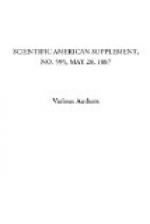The wave theory of sound starts off with the assumption that the atmosphere is composed of molecules, and that these supposed molecules are free to vibrate when acted upon by a vibrating body. When a tuning fork, for example, is caused to vibrate, it is assumed that the supposed molecules in front of the advancing fork are crowded closely together, thus forming a condensation, and on the retreat of the fork are separated more widely apart, thus forming a rarefaction. On account of the crowding of the molecules together to form the condensation, the air is supposed to become more dense and of a higher temperature, while in the rarefaction the air is supposed to become less dense and of lower temperature; but the heat of the condensation is supposed to just satisfy the cold of the rarefaction, in consequence of which the average temperature of the air remains unchanged.
The supposed increase of temperature in the condensation is supposed to facilitate the transference of the sound pulse, in consequence of which, sound is able to travel at the rate of 1,095 feet a second at 0 deg.C., which it would not do if there was no heat generated.
In other words, the supposed increase of temperature is supposed to add 1/6 to the velocity of sound.
If the tuning fork be a Koenig C^{3} fork, which makes 256 full vibrations in one second, then there will be 256 sound waves in one second of a length of 1095/256 or 4.23 feet, so that at the end of a second of time from the commencement of the vibration, the foremost wave would have reached a distance of 1,095 feet, at 0 deg.C.
The motion of a sound wave must not, however, be confounded with the motion of the molecules which at any moment form the wave; for during its passage every molecule concerned in its transference makes only a small excursion to and fro, the length of the excursion being the amplitude of vibration, on which the intensity of the sound depends.
Taking the same tuning fork mentioned above, the molecule would take 1/256 of a second to make a full vibration, which is the length of time it takes for the pulse to travel the length of the sound wave.
For different intensities, the amplitude of vibration of the molecule is roughly 1/50 to 1/1000000 of an inch. That is to say, in the case of the same tuning fork, the molecules it causes to vibrate must either travel a distance of 1/56 or 1/1000000 of an inch forward and back in the 1/256 of a second or in one direction in the 1/512 of a second.
I might further state that the pitch of the sound depends on the number of vibrations and the intensity, as already indicated by the amplitude of stroke—the timbre or quality of the sound depending upon factors which will be clearly set forth as we advance.
Having now clearly and correctly represented the wave theory of sound, without touching the physiological effect perceived by means of the ear, we will proceed to consider it.




